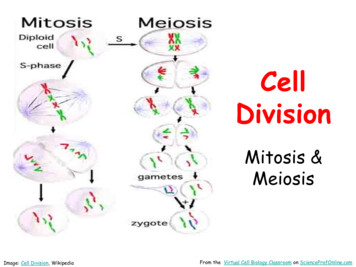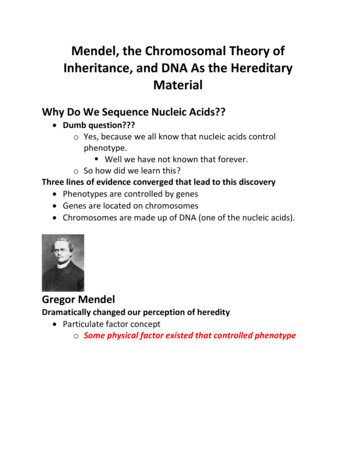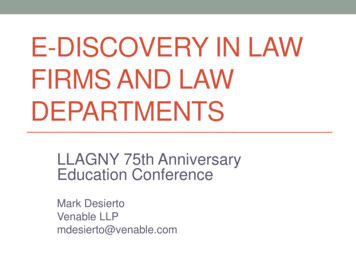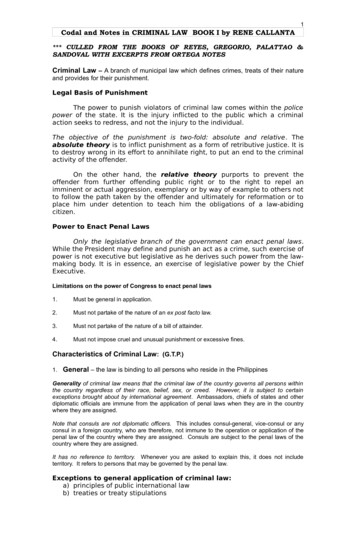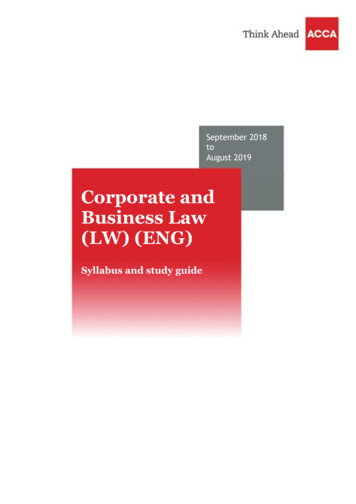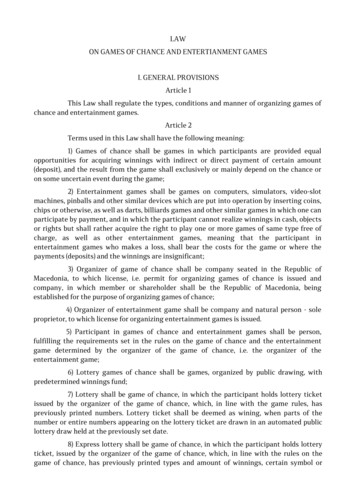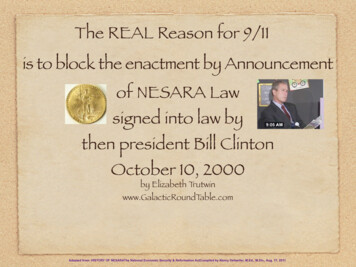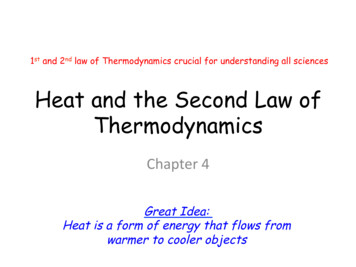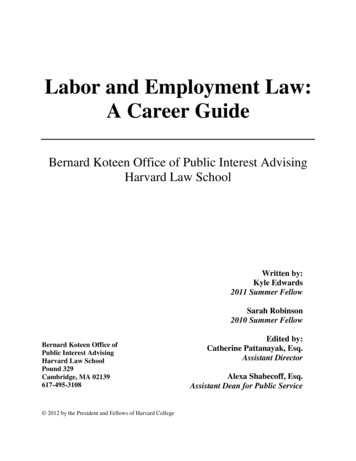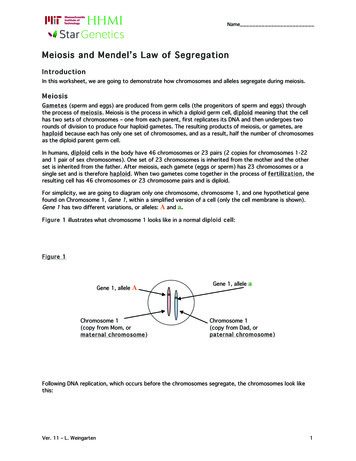
Transcription
NameMeiosis and Mendel’s Law of SegregationIntroductionIn this worksheet, we are going to demonstrate how chromosomes and alleles segregate during meiosis.MeiosisGametes (sperm and eggs) are produced from germ cells (the progenitors of sperm and eggs) throughthe process of meiosis. Meiosis is the process in which a diploid germ cell, diploid meaning that the cellhas two sets of chromosomes – one from each parent, first replicates its DNA and then undergoes tworounds of division to produce four haploid gametes. The resulting products of meiosis, or gametes, arehaploid because each has only one set of chromosomes, and as a result, half the number of chromosomesas the diploid parent germ cell.In humans, diploid cells in the body have 46 chromosomes or 23 pairs (2 copies for chromosomes 1-22and 1 pair of sex chromosomes). One set of 23 chromosomes is inherited from the mother and the otherset is inherited from the father. After meiosis, each gamete (eggs or sperm) has 23 chromosomes or asingle set and is therefore haploid. When two gametes come together in the process of fertilization, theresulting cell has 46 chromosomes or 23 chromosome pairs and is diploid.For simplicity, we are going to diagram only one chromosome, chromosome 1, and one hypothetical genefound on Chromosome 1, Gene 1, within a simplified version of a cell (only the cell membrane is shown).Gene 1 has two different variations, or alleles: A and a.Figure 1 illustrates what chromosome 1 looks like in a normal diploid cell:Figure 1Gene 1, alleleAChromosome 1(copy from Mom, orm ate rnal c hrom osome)Gene 1, alleleaChromosome 1(copy from Dad, orp ater nal c hrom osome)Following DNA replication, which occurs before the chromosomes segregate, the chromosomes look likethis:Ver. 11 – L. Weingarten1
NameFigure 2Homologous Chromosomes!Chromosomes carrying thesame genes in the samelocations, originating fromdifferent parents !Gene 1 (alleleA)!! !!!! !!Gene 1 (alleleCentromeres!DNA sequence or region onthe chromosome wherechromatids are held togetherand the spindles attach!Chromatid!Chromatid!Sister Chromatids!a)!! !! !! !!Chromatid!Chromatid!Sister Chromatids!!After DNA replication, we begin to call each duplicated chromosome a “chromatid.” Eachduplicated chromosome contains two chromatids, or “sister chromatids”, which are identical inDNA sequence until recombination occurs later in meiosis. The word chromatid is only used torefer to each copy of the duplicated chromosome before sister chromatids segregate inAnaphase of Meiosis II. After this, each chromatid is again referred to as a chromosome.!Chrom osom e & Allele Segregation in MeiosisNow we are going to diagram the process of chromosome segregation during meiosis. Figure 3 illustratesthe segregation of Gene 1 in a male germ cell that is undergoing meiosis in the gonad, which is thegamete-producing organ (ex: testes in humans). This diagram only illustrates Chromosome 1 and Gene 1,which is located on Chromosome 1.Ver. 11 – L. Weingarten2
NameFigure 3Haploid or Diploid?"Aa"Germ Cell"Genotype:Diploid"Aa!DNA Replication"A"AaaDiploid"Metaphase I"Homologous chromosomesalign at metaphase plate"AaDiploid""Anaphase I"Homologous chromosomesseparate"Metaphase II"Chromosomes align at themetaphase plate"AaA"aHaploid""Anaphase II"Sister chromatids ination during meiosis:Recombination is the exchange of DNA sequences between two chromatids at a given loci, which mayresult in single chromatids that contain both maternal and paternal DNA sequences. Recombination occursin Prophase of Meiosis I (when the homologous chromosomes pair up), which takes place after DNAreplication and before Metaphase I. In Figure 3, recombination is not shown for simplicity.Ver. 11 – L. Weingarten3
NameUse Figure 3 to answer questions a-g below:a) What is the genotype of the germ cell?b) How many different alleles does the germ cell have?c) Is the genotype of the germ cell homozygous or heterozygous?d) Write the genotypes of the gametes in the spaces provided in the figure above.e) How many copies of Chromosome 1 does each gamete have?f) How many alleles of Gene 1 does each gamete have?g) How many gametes have the genotypeA: /4 %a: /4 %Aa genotype with respect to Gene 1.How many different gamete genotypes will result from meiosis in the Aa female germ cell?h) Now imagine that there is a female germ cell which also has theSUM M ARYEach DIPLOID germ cell has 2 COPIES of a gene. Through meiosis, germ cells produce gametes, whichcontain only a single copy of the gene. In other words, alleles segregate through the process ofgenerating reproductive cells, or meiosis. THIS DESCRIBES MENDEL’S LAW OF SEGREGATIONFertilizationNow, let’s think about what will happen if a sperm from thefemale parent.Aa male parent fertilizes an egg from the AaIn the male parent, (Parent 1, blue chromosomes), meiosis will generate two types of gametes with eitherthe genotype A or a with respect to Gene 1, as illustrated above. Therefore, the resulting offspring willinherit either allele,A or a, of Gene 1 based on random chance:AaIf the genotype of the female parent, (Parent 2, pink chromosomes) with respect to Gene1 is alsothen the offspring will also inherit either allele,AVer. 11 – L. WeingartenAa,A or a, of Gene 1 based on random chance:a4
Namei) What are the possible genotypes of the offspring of a cross between anAa male parent x Aa femaleparent? Fill in Punnett Square below with the possible genotypes of the gametes and offspring.Mother’s gametes"A!A!Father’sgametes "a!a!""""The outside of the Punnett Square is reserved for the alleles that make up the genotype of the parentalgametes. The inside of the Punnett Square illustrates the four possible outcomes of a fertilization eventinvolving the two specific parental gametes. All of the combinations are equally likely, meaning that thereis a 1/4 chance of each outcome occurring due to Mendel’s Law of Segregation.A allele, the resulting offspring’s genotypes are those in the dark pinkcolumn. If the mother contributes the a allele, the resulting offspring’s genotypes are those found in theIf the mother contributes thelight pink column.If the father contributes theif he contributes theA allele, the genotype of the resulting offspring are in the dark blue row, anda allele, the genotype of the resulting offspring are those in the light blue row.j) Answer questions i-vi below based on your Punnett Square in i). How many gametes have:i) A homozygous genotype?ii) A heterozygous genotype?iii) The genotypeaa?iv) The mother’s genotype?v) A genotype different from the father?vi) The genotype Aa? Hint: Does the order inwhich you write the alleles of a genotype changethe genotype?Ver. 11 – L. Weingarten5
Namek) Using Figure 3 as an example, complete the diagram below to demonstrate meiosis in a parent with anaa genotype for Gene 1:i. Draw Chromosome 1 in the cells below to demonstrate how this representative chromosomesegregates during the different stages of meiosis. Show the location of Gene 1 on thechromosome with a line, label the alleles (A or a) appropriately in ALL STAGESii. List the ploidy and the genotypes of the gametes at each stage provided below.Germ Cell!Genotype:!Haploid or Diploid?!aa!!DNA Replication!!!!!Metaphase I!Homologous chromosomesalign at metaphase plate!Anaphase I!Homologous chromosomesseparate!Metaphase II!Chromosomes align at themetaphase plate!!!!Anaphase II!!!!!!Gametes!GENOTYPES:Ver. 11 – L. Weingarten!6
Namel) Based on your figure above, how many different genotypes do you observe in the resulting gametes?m) If anaa male parent mates with an Aa female, what are the possible genotypes of the resultingoffspring? Fill in the Punnett Square below with the possible outcomes.Mother’s GametesFather’s GametesSUM M ARYEach offspring gets a total of 2 COPIES of each gene through the process of FERTILIZATION.One copy (one allele, ex: A or a) is inherited from the mother and one copy (one allele, ex: A or a) isinherited from the father.These two alleles may be the same or different, depending on the genotype of the parents and randomchance of two particular gametesIf the alleles (ex: A or a) for a single gene are THE SAME (ex: AA or aa), this individual is HOMOZYGOUSfor this gene.If the alleles (ex: A or a) for a single gene are DIFFERENT (ex: Aa), the individual is HETEROZYGOUS forthis gene.Applying Your Knowledge: Meiotic Errors and Non-disjunctionAn error can occur in meiosis when chromosomes or chromatids do not separate properly in meiosis. Thisis called non-disjunction. There are two ways in which non-disjunction can occur: 1) both homologouschromosomes migrate together to one pole instead of separating to opposite poles in Anaphase I or 2)sister chromatids fail to separate properly and both sister chromatids move together to one pole insteadof to opposite poles in Anaphase II.n) What are the genotypes of the gametes in theAa male we first examined at the beginning of thisworksheet, if a non-disjunction event occurred in Anaphase II and the sister chromatids failed to separateinto two daughter cells? Fill in the table below with the genotypes of each of the 4 gametes.Note: Assume the non-disjunction event occurs when the precursor cell that gives rise to gametes 1and 2 divides improperly.Ver. 11 – L. Weingarten7
NameGamete 1Gamete 2Gamete 3Gamete 4Normal MeiosisNon-Disjunction inMeiosis IIo) When a gamete with an abnormal number of chromosomes due to a non-disjunction event is fertilized,the resulting zygote will be aneuploid (having an irregular chromosome number). Two specific types ofaneuploidy are trisomy, where each cell in the offspring has three copies of a single chromosome insteadof two, and monosomy, where the offspring has only one copy of a single chromosome instead of two.The cross of an aa male and Aa female produced an offspring with the genotype AAa. Therefore, theresulting offspring has 3 copies of gene 1 (trisomy for Chromosome 1). At what stage during meiosis didthe non-disjunction event occur and in which parent? Circle all of the answers that apply.a) Paternal non-disjunction in Meiosis Ib) Maternal non-disjunction in Meiosis Ic) Paternal non-disjunction in Meiosis IId) Maternal non-disjunction in Meiosis IIVer. 11 – L. Weingarten8
Following DNA replication, which occurs before the chromosomes segregate, the chromosomes look like this: Chromosome 1 (copy from Mom, or maternal chromosome) Chromosome 1 (copy from Dad, or paternal chromosome) Gene 1, allele a Gene 1, allele A. Name_ Ver. 11 – L. Weingarten 2 Figure 2 Chromosome & Allele Segregation in Meiosis Now we are going to diagram the process of
